Recipe, pages 96-99. Continued from AYU, Kombu, Fried Spine, Sesame (Part 1)
Day 2 (Saturday)
Sesame Pudding (Continued)
The next morning, the sesame milk had steeped to a wonderfully aromatic goodness. I strained it into a medium saucepan.
And brought it to a simmer.
Then I whisked in the agar agar to thicken, and removed from the heat. I strained it through a chinois (Which, by the way, is not looking too good. It’s a French chinois, so I thought it would be a long-lasting, handy kitchen tool. But the thing’s already disappointingly rusting in spots! So what’s the lifespan of a much-used strainer?) into a shallow bowl and cooled until set.
This is where we do the Alinea Pudding Dance, transform a liquid to a solid and back to a liquid state (pudding). I roughly chopped the gelled sesame milk and placed it into my Cuisinart mini food processor. Then blended on high, and added a little sesame oil to loosen it up.
Pushed it through a strainer into a plastic container and reserved in the fridge. You could also transfer to a pastry bag or squeeze bottle.
This is pretty tasty stuff — I’ll end up using this recipe in many dishes to come!
Ingredients
Plumped white sesame seeds, from above
Sesame oil
Whole milk
C&H cane sugar
Diamond Crystal kosher salt
Agar agar
Hato Mugi Salad
I used fresh squeezed lime juice for this.
And grated the zest with a Microplane. Oops. It broke! If you get one, make sure to get the all-metal Microplane, it won’t break under the heavy Lindsay hand like the plastic…
Mise en place:
I used the rest of the hato mugi I’d prepared the day before, and combined with the plumped white and black sesame seeds, the sesame pudding, some lime juice and zest in a medium bowl. Then lightly salted, to taste.
At first glance, my daughter said that the finished hato mugi salad resembled cat vomit.
I coaxed her into trying it. She reluctantly admitted that she liked it very much.
“But it still looks weird, though,” she said.
Ingredients
Cooked hato mugi, from day before
Plumped white sesame seeds, from above
Plumped black sesame seeds, from above
Sesame pudding, from above
Lime juice
Finely grated lime zest
Diamond crystal kosher salt, to taste
Braised Kombu
What we’re doing here is taking an otherwise inedible piece of dried seaweed, reconstituting it, and braising the hell out of it in a home-made teriyaki sauce. Kombu, (Laminaria japonica) seaweed, also known as dashima in Korean and haidai in Chinese, is a staple of Asian cooking. It’s mainly used as a flavor base for dashi broths and soups. But to eat it, you have to cook it a long time.

You can find teriyaki-flavored kombu in Asian markets just as easliy as you can teriyaki-flavored jerky at any 7-Eleven or Circle K. And if you’re so-inclined, you can use the packaged teriyaki-style kombu instead of making your own.
I got a package of dried kombu, or dashi kombu, at Mitsuwa Marketplace. Sorry, I forgot to add this to the previous post, because this part should be done on day one. I soaked the kombu sheet in water overnight in the refrigerator.
I put the sugar in a heavy saucepan and brought up the heat to carmelize. You’ll see it first melt, then start to turn brown.
When it did, I added the diced carrot, lemongrass, chili, shallots and ginger, stirring to coat, and cooked for a bit.
Then added the liquids: soy, sake and water. I brought it all to a boil, then removed from the heat to steep.
I pre-heated the oven to 350ºF.
After the veggies had steeped for awhile, I strained through a chinois. Then I removed the kombu sheet from the fridge, drained and cut into strips.
Put into a baking dish and covered with the strained teriyaki braising liquid. This is supposed to braise for 3-4 hours, so I thought I was good to go…
If you decide on making your own, whatever you do, don’t leave it in the oven, thinking that picking up your kids will be “just a quick trip.” This is what mine looked like before…
… and after we eventually returned home.
A solid block of carbon. Like what happened to Han Solo, now that I think of it.
So I made the whole recipe all over again. This time staying put.
That’s better.
I removed the kombu from the teriyaki braising liquid, and trimmed into thin strips. Then reserved in a plastic bag.
Ingredients
Dried sheet of kombu
C&H cane sugar
Fresh carrot, peeled and diced
Fresh lemongrass. chopped
Dried chili flakes
Diced shallot
Fresh ginger root, peeled and diced
Kikkoman “low sodium” soy sauce
Sake
Water
Kombu Syrup
I didn’t even have to reduce the liquid down; it was already just right. So all I did was to strain it into a plastic squeeze bottle. Good to go. You may have to simmer yours for awhile until it thickens up.
Ingredient
Reserved kombu teriyaki liquid
Ayu Fillets
I hadn’t cleaned a fish since the last time I took my son fishing, and that was about nine years ago.
Bad Dad.
But it’s like riding a bicycle, right?
Probably cause I was never instilled with great fishing skills from my dad, who was a better hunter. As a young boy, I remember fishing with him in the streams of some Oregon river valley — for what seemed like an eternity — only to catch a few crawdads. Not quite like The River Runs Through It.
I’m sure he wanted to go shoot something, rather than fish. I must say, we did enjoy those venison steaks.
I scaled the ayu under some running water in the sink. Rubbing back and forth with the back of a large kitchen knife (or fish scaler, if you have one), removes the few scales on the skin. Then I patted them dry.
There’s a lengthy description in the book describing how to fillet the fish. Basically what you want to do is to cut the fillets from the left and right sides of the fish’s spine. And keeping the spine intact is tricky — my heavy “Lindsay hand” destroyed the first one right quick.
I cut down from right behind its gills.
Then kept going down along its spine and over the ribs, which you can feel as you drag the knife. You want to keep the spine intact, cause we’re eatin’ it!
Then removed the fillet, and repeated on the other side.
I removed the fins that were still attached, had a pile o’ guts. Then removed any ribs and leftover meat from the spines, and reserved for later.
I took the skin off one from each set of fillets. Once it gets started, it’s easy to peel off. I had some plastic wrap ready to roll the fillets.
I put a fillet down, skin side down, on the plastic. Salted. Then topped with the skinless fillet, and rolled very tightly in the plastic.
I twisted the ends shut and tucked under the fillets, then reserved the fish rolls for service.
Fried Spines and Skin
Now for them there little spines! I put the cleaned spines in a small pot of water and boiled for about five minutes. Removed any clinging stuff and reserved to dry on a paper towel.
Then put them on a plate with the skins next to a pot of canola oil, heated to 350ºF.
Fried them until they browned and stopped bubbling, then drained on paper towels.
Then upped the oil to 400ºF and fried the skins. These fried quickly and popped hot oil. Careful.
Ingredients
8 Whole Japanese ayu, from Mitsuwa
Diamond Crystal kosher salt
Canola oil
Cilantro sauce
Cilantro is very plentiful here in San Diego. But, I can get it cheaply, or expensively. Depending on where I go. Usually the Mexican markets have it for the best prices. This time I got several bunches at North Park Produce. Picked the leaves off the stems, and saved them (the stems) for later.
Boiled a large pot of water with some salt added, for our big pot blanching. Blanched the cilantro leaves until they turned bright green and dissolved when rubbed together between your fingers. Plunged into an icebath to cool, then transferred to my bar blender with some cold water.
Blended until smooth then strained.
I put it back in the blender, and blended again, this time with the simple syrup and Ultra-Tex 3.
After it thickened up, I transferred the sauce to a small plastic squeeze bottle.
Ingredients
Bunch fresh cilantro
Water
Diamond Crystal kosher salt
Ice water
Diamond Crystal kosher salt, to taste
Simple syrup
Ultra-Tex 3, from Le Sanctuaire
Candied Cilantro Stems
After everything was said and done, I felt like this could have been left off the dish. No matter how long I simmered them, the cilantro stems were still tough and stringy. I put em on anyway…
I cut up the reserved stems and simmered them in some simple syrup for the 20 seconds, then added them to some reserved syrup, as directed. Chewy. Stringy. So I cooked them some more. Still stringy. Hmmm.
Ingredients
Reserved cilantro stems
Simple syrup
Coriander Salt
I toasted the coriander seeds in a small dry skillet until they were aromatic. Removed them from the heat and ground to a fine powder in my spice grinder. Then passed through a small sieve and mixed together with the salt in a plastic container.
Ingredients
Dried coriander seeds
Diamond Crystal kosher salt
To Assemble and Serve
Now I was finally ready to serve! I got all my mise ready, including some grated lime zest, and cilantro leaves and flowers from my garden.
If you let your cilantro plants flower, you’ll end up with everything you need. The small leaves near the top are just as good as “micro” cilantro; you’ll have the edible flowers, and if you wait — pungent, green coriander seeds.
Then got out my new Alinea “Dune” serveware by Crucial Detail.
I heated up the steamer and added the ayu cylinders. I steamed them until their flesh turned whitish, under ten minutes.
Here’s the whole prep area setup (notice the shoju and sakes in background):

Plating
I placed a watermelon plank on the plate, and topped it with the hato mugi salad.
At one end, I put about a dozen pieces of the puffed hato mugi.
I removed the fish rolls from the steamer and let rest a few minutes, then unwrapped and trimmed off the rounded edges.
I seasoned the fish roll with coriander salt and a little lime zest, then placed atop the hato mugi salad, skin side up. Then began adding layers.
I added some loops of the braised combo and a couple pieces of the pickled watermelon rind. Then some of the candied cilantro stems. I randomly added some coriander flowers, and small cilantro leaves to garnish.
Then added a 2-inch piece of fried spine and skin. There are detailed instructions in the cookbook on how to exactly position each component, so I won’t go into them here. But use your own creativity!
Then I poured some sesame oil into the divot in the plate next to the fish. Added a squeeze of cilantro sauce, and dotted with kombu syrup. Finally, garnished with some fresh coriander seeds. I got these from the plants in my garden, which I had let flower for a week or two.
Now we were ready to eat! It was pretty good. Although I could have done without the cilantro stems. Everything worked together, except them. The kombu-syrup-teriyaki-sauce mixed very well with the sesame and watermelon. There was a sweet, tangy crunch from the pickled rind. All with a subtle coriander flavoring overall.
Ingredients
Finely grated lime zest
Fresh coriander flowers, leaves and seeds, from my garden
Sesame oil
Equipment
Salter digital scale
Measuring bowls
Cutting board and kitchen knife
FoodSaver vacuum sealer and bags
Medium saucepan
Wire whisk
Pressure cooker
Stainless steel bowls
Baking dish
Osterizer blender
Rubber spatula
Strainer, sieve or chinois
Deep fryer or large pot for frying
Electronic thermometer
Sheet trays and paper towels
Plastic wrap
Plastic squeeze bottles
Tweezers
Plastic Gladware containers
Serveware
Alinea “Dune” plates by Crucial Detail, from J.B. Prince
Yields: Eight servings, with lots of leftover sesame seeds, hato mugi, sesame pudding and braised kombu.
Goes well with: Hendrick’s gin martini, cucumber martini (Zubrowka buffalo grass vodka, cucumber, black pepper syrup), shoju or a nice junmai daiginjo sake.
Resources
| Item | Price | Source |
| seedless watermelon | $0.50 / 3 pounds | North Park Produce |
| Kikkoman low-sodium soy sauce | $6.99 / 750mL (25.4 fl oz) | Mitsuwa Marketplace |
| Haitai pearl barley | $2.99 / 453.6g (16 oz) | Zion Marketplace |
| Mizkan brown rice vinegar | $5.99 / 500mL (16.5 fl oz) | Zion Marketplace |
| Fresh ginger root | $1.29 / pound | Mitsuwa Marketplace |
| Fresh lemongrass | $0.99 / bunch | Mitsuwa Marketplace |
| Fresh red Thai chili | $1.29 / packet | Vien Dong World Market |
| Kadoya sesame oil | $14.99 / 1.66L (56 fl oz) | Zion Marketplace |
| irikuro roasted black sesame seeds | $6.99 / 500g (17.6 oz) | Zion Marketplace |
| irishiro roasted sesame seeds | $6.99 / 500g (17.6 oz) | Zion Marketplace |
| dried dashi kombu seaweed sheets | $3.99 / 85g(3 oz) | Mitsuwa Marketplace |
| ayu sweetfish | $3.99 / 2 | Mitsuwa Marketplace |
| fresh cilantro | $0.50 / bunch – $1.49 / bunch | Various |

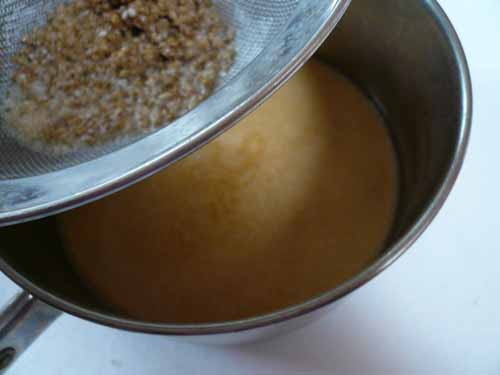
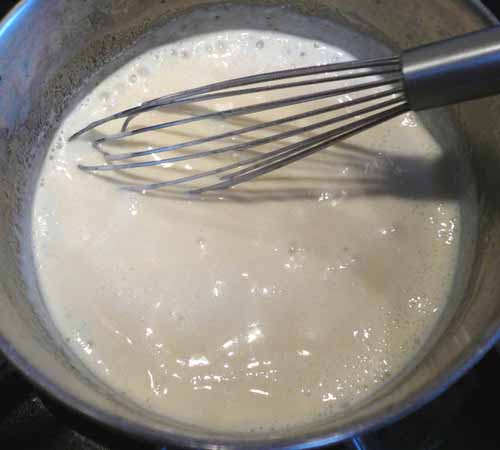
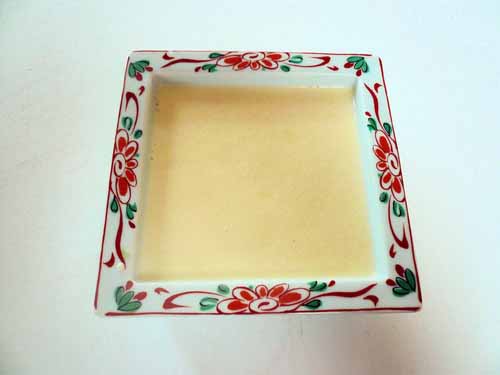
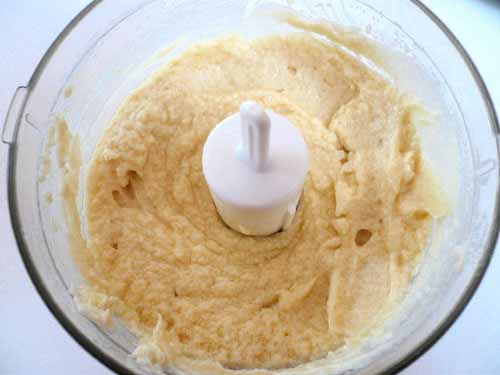
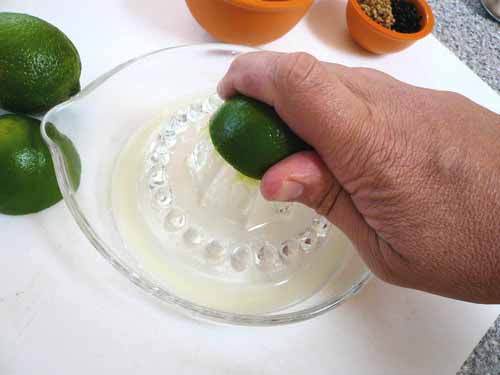

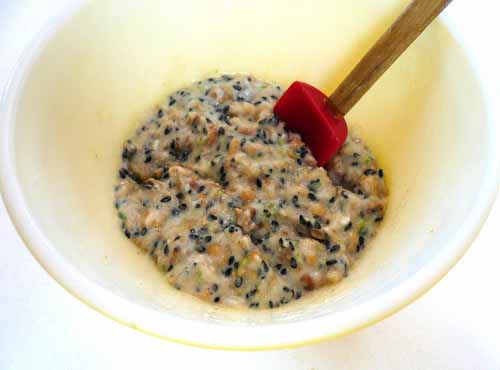
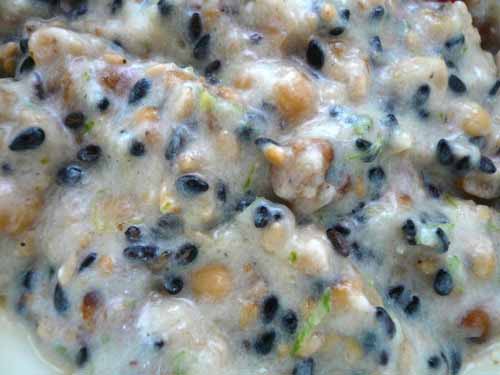
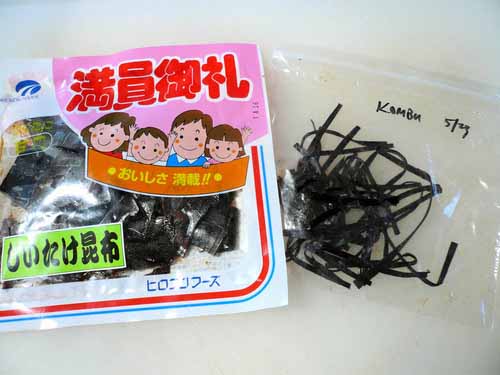
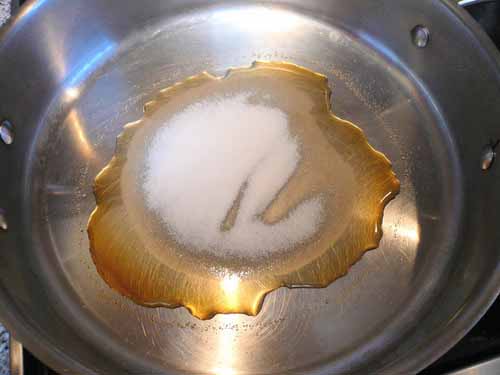
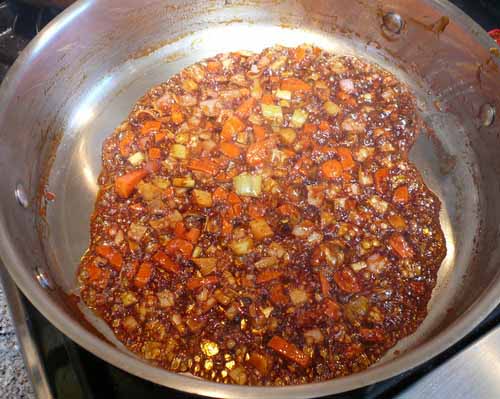
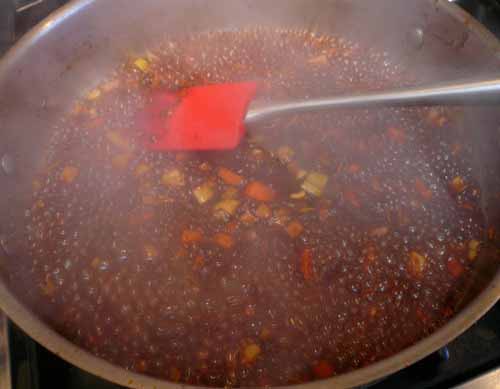
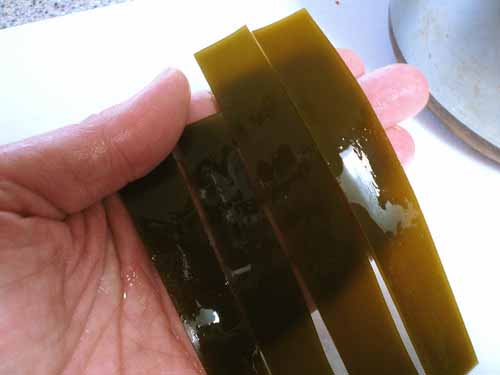
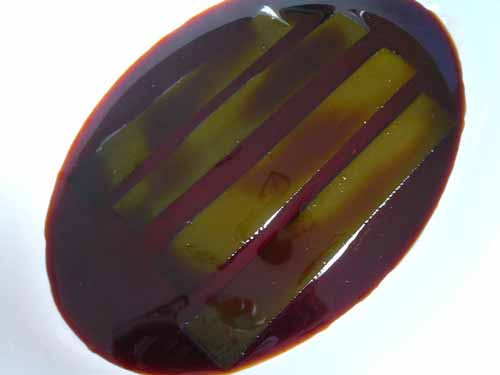
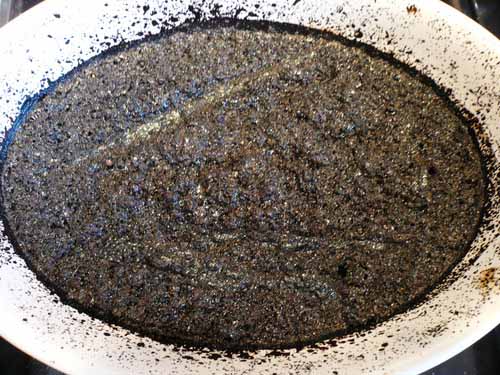
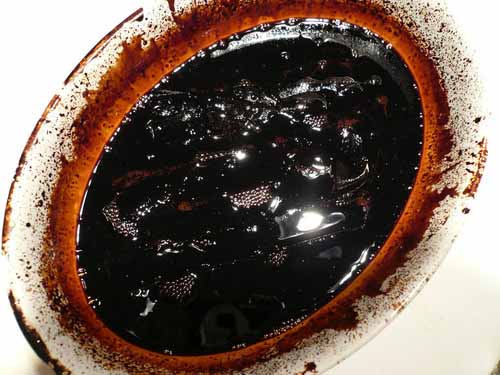
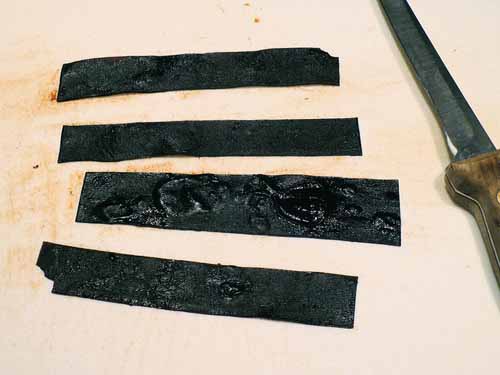
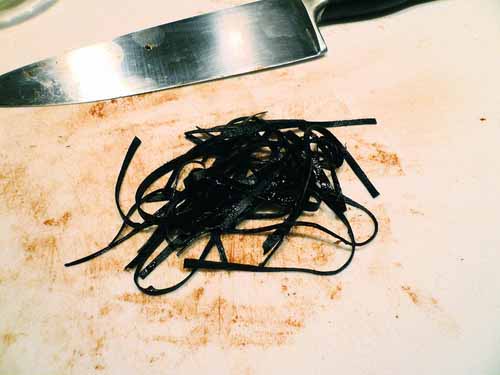
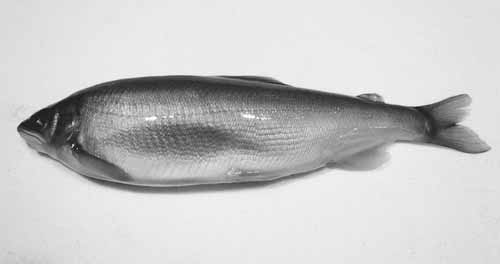


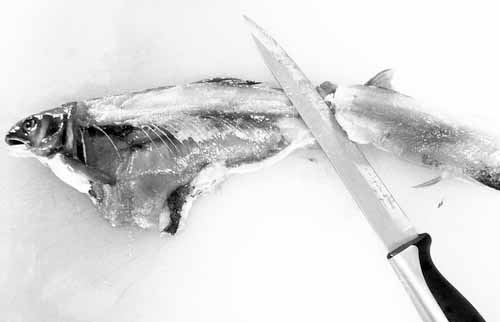



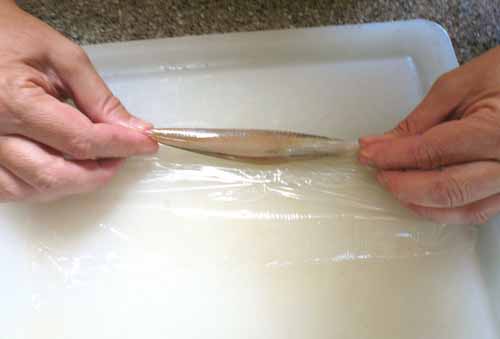

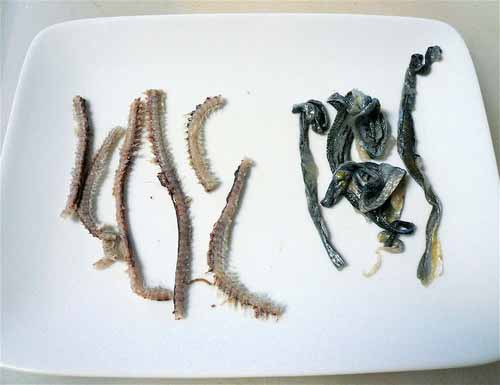
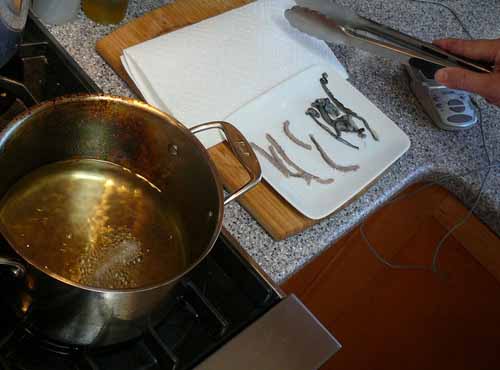
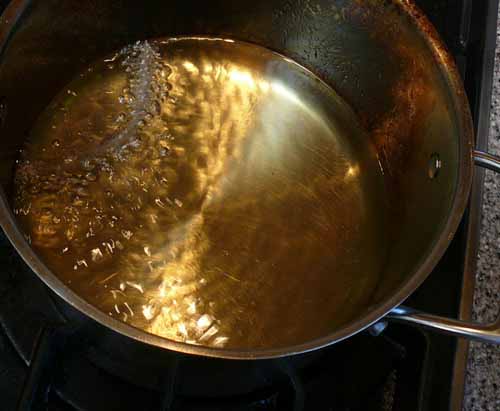

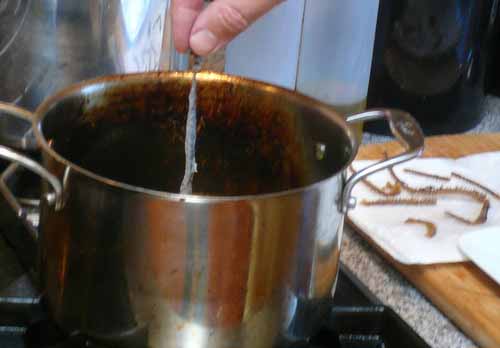

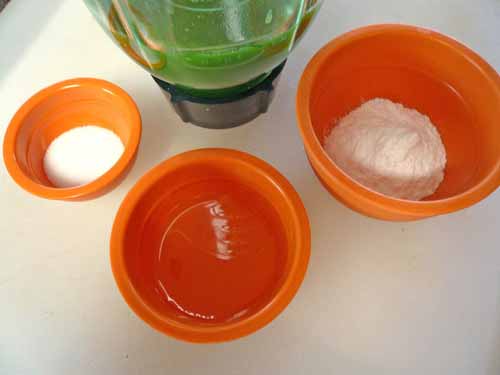
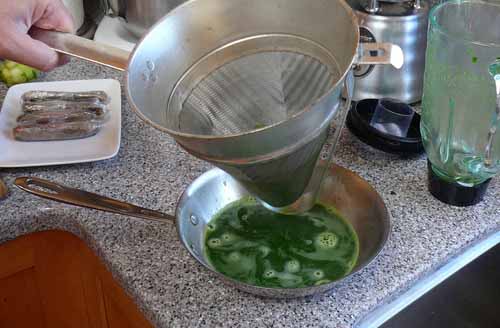



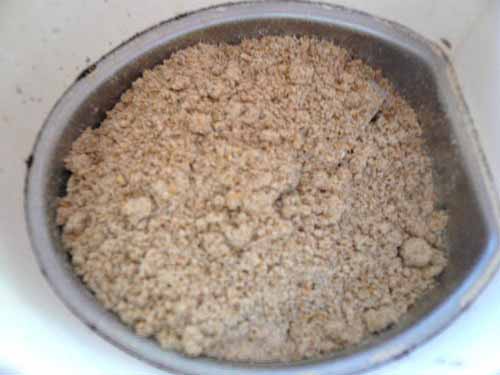
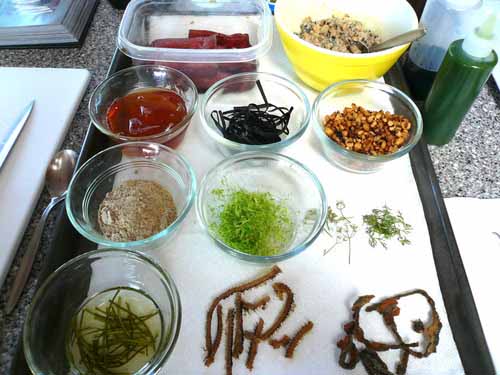
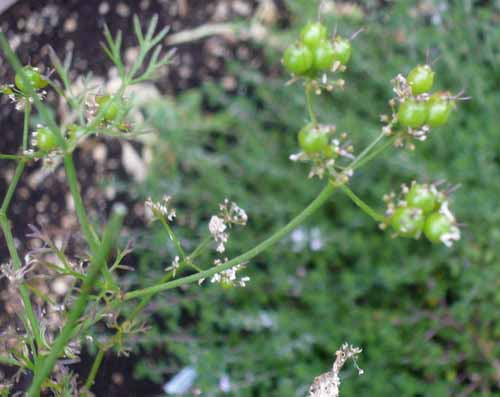

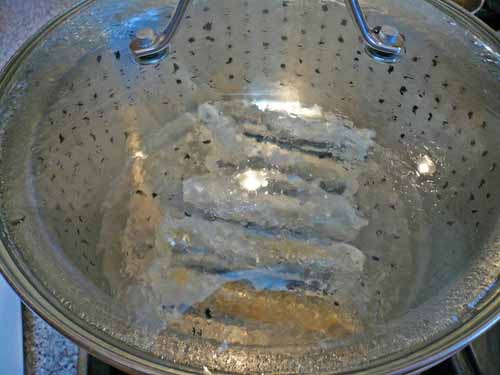
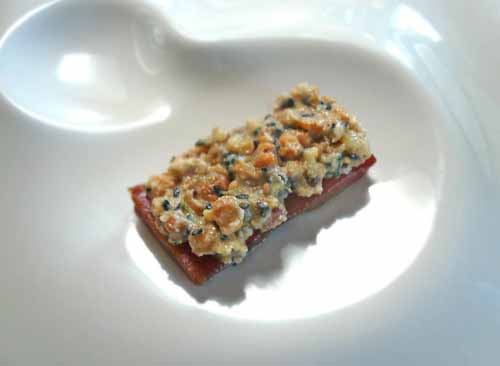
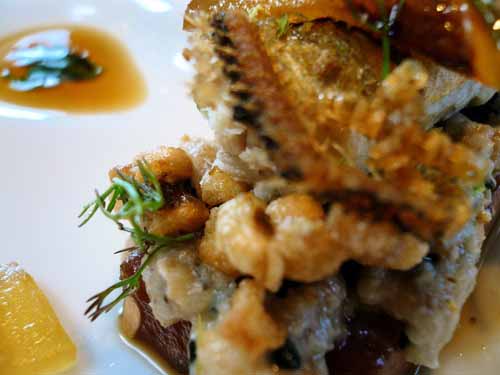
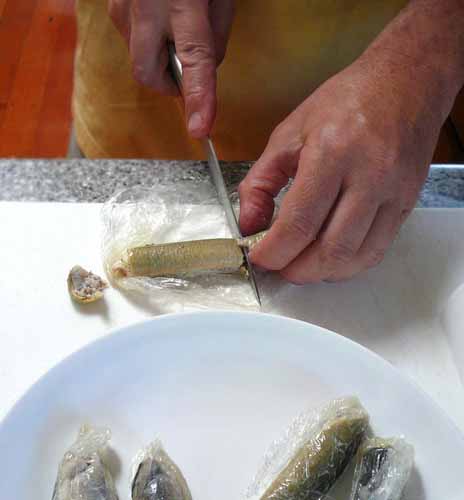
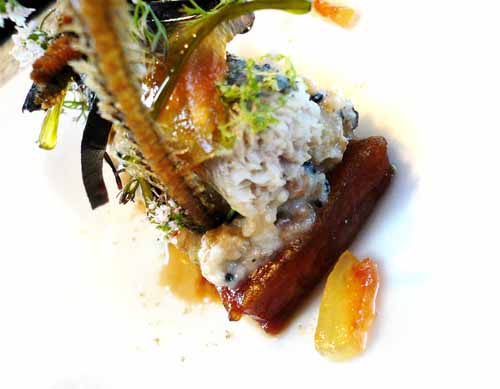
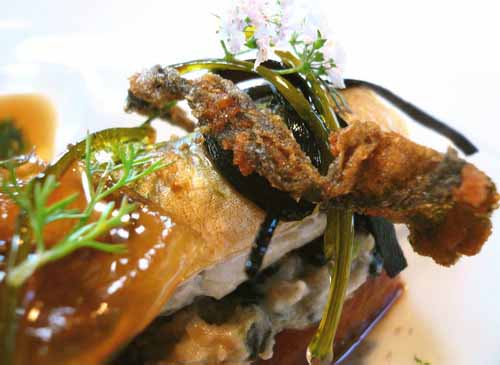

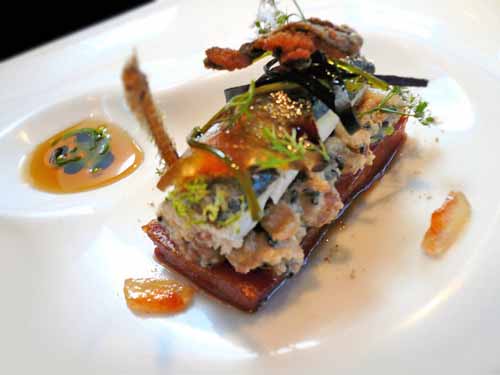
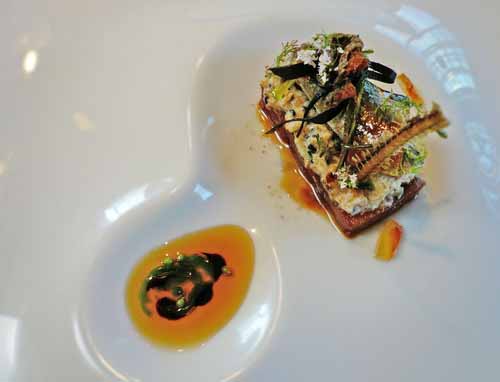
4 Responses to AYU, Kombu, Fried Spine, Sesame (Part 2)